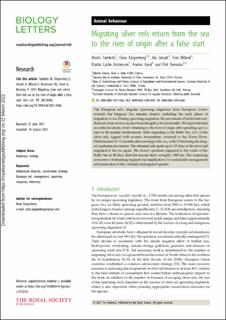| dc.contributor.author | Tambets, Meelis | |
| dc.contributor.author | Kärgenberg, Einar | |
| dc.contributor.author | Järvalt, Ain | |
| dc.contributor.author | Økland, Finn | |
| dc.contributor.author | Kristensen, Martin Lykke | |
| dc.contributor.author | Koed, Anders | |
| dc.contributor.author | Bernotas, Priit | |
| dc.date.accessioned | 2022-03-25T13:04:35Z | |
| dc.date.available | 2022-03-25T13:04:35Z | |
| dc.date.created | 2022-02-15T13:22:43Z | |
| dc.date.issued | 2021 | |
| dc.identifier.citation | Biology Letters. 2021, 17 (9), 1-8. | en_US |
| dc.identifier.issn | 1744-9561 | |
| dc.identifier.uri | https://hdl.handle.net/11250/2987672 | |
| dc.description.abstract | The European eel’s singular spawning migration from European waters towards the Sargasso Sea remains elusive, including the early phase of migration at sea. During spawning migration, the movement of freshwater resident eels from river to sea has been thought to be irreversible.We report the first recorded incidents of eels returning to the river of origin after spending up to a year in the marine environment. After migrating to the Baltic Sea, 21% of the silver eels, tagged with acoustic transmitters, returned to the Narva River. Half returned 11–12 months after moving to the sea, with 15 km being the longest upstream movement. The returned eels spent up to 33 days in the river and migrated to the sea again. The fastest specimen migrated to the outlet of the Baltic Sea in 68 days after the second start—roughly 1300 km. The surprising occurrence of returning migrants has implications for sustainable management and protection of this critically endangered species. behavioural diversity, conservation strategy, European eel, management, spawning migration, telemetry | en_US |
| dc.language.iso | eng | en_US |
| dc.subject | Atferd | en_US |
| dc.subject | Behaviour | en_US |
| dc.subject | behavioural diversity | en_US |
| dc.subject | conservation strategy | en_US |
| dc.subject | European eel | en_US |
| dc.subject | management | en_US |
| dc.subject | spawning migration | en_US |
| dc.subject | telemetry | en_US |
| dc.title | Migrating silver eels return from the sea to the river of origin after a false start | en_US |
| dc.type | Peer reviewed | en_US |
| dc.type | Journal article | en_US |
| dc.description.version | publishedVersion | en_US |
| dc.rights.holder | © 2021 The Authors | en_US |
| dc.subject.nsi | VDP::Zoologiske og botaniske fag: 480 | en_US |
| dc.subject.nsi | VDP::Zoology and botany: 480 | en_US |
| dc.subject.nsi | VDP::Zoologiske og botaniske fag: 480 | en_US |
| dc.subject.nsi | VDP::Zoology and botany: 480 | en_US |
| dc.source.pagenumber | 1-8 | en_US |
| dc.source.volume | 17 | en_US |
| dc.source.journal | Biology Letters | en_US |
| dc.source.issue | 9 | en_US |
| dc.identifier.doi | 10.1098/rsbl.2021.0346 | |
| dc.identifier.cristin | 2001800 | |
| dc.relation.project | Andre: European Fisheries and Maritime Fund project L180152PKKH | en_US |
| dc.relation.project | Andre: Estonia-Russia Cross Border Cooperation Programme 2014-2020 | en_US |
| dc.source.articlenumber | 20210346 | en_US |
| cristin.ispublished | true | |
| cristin.fulltext | original | |
| cristin.qualitycode | 2 | |
